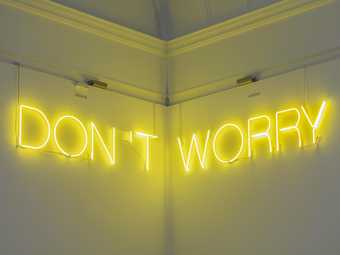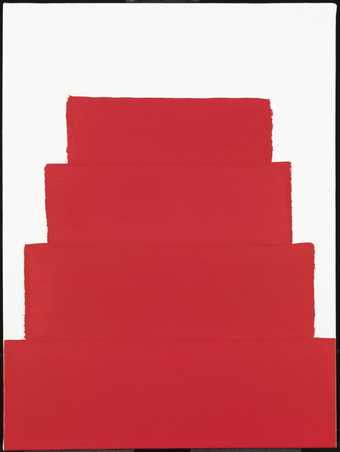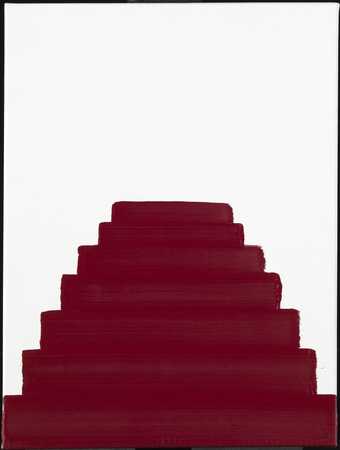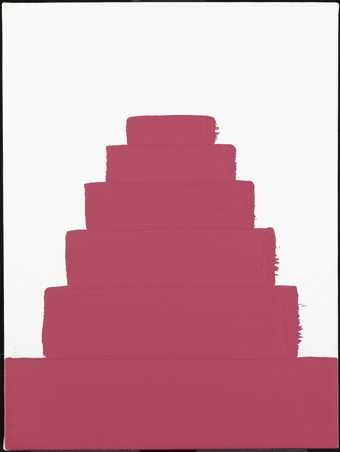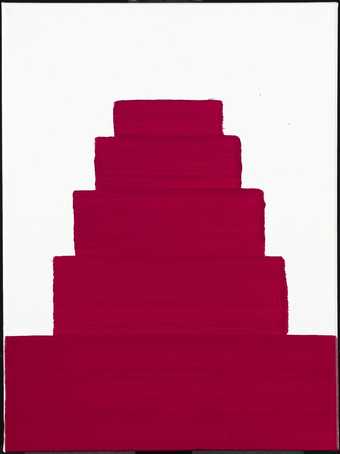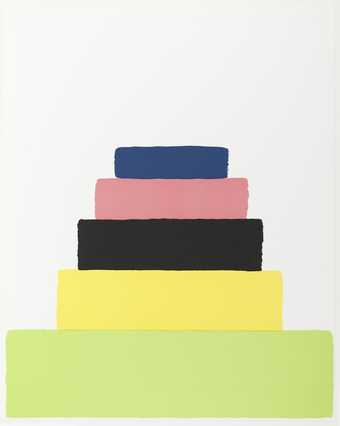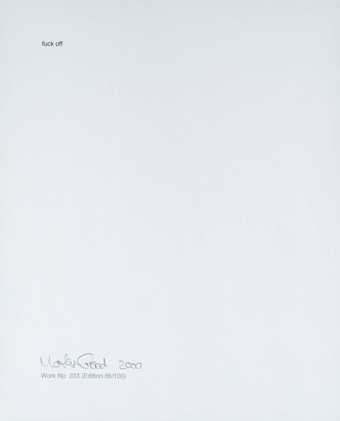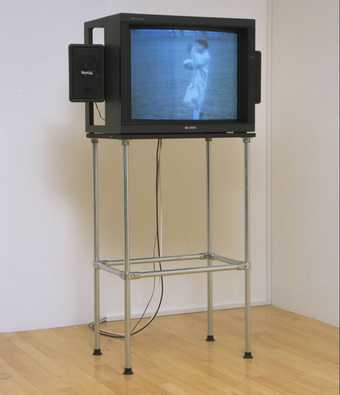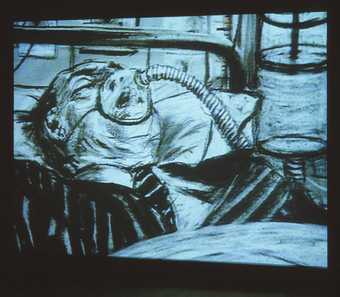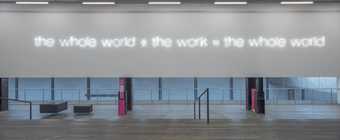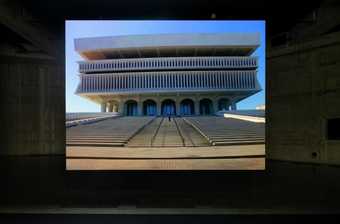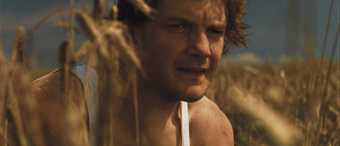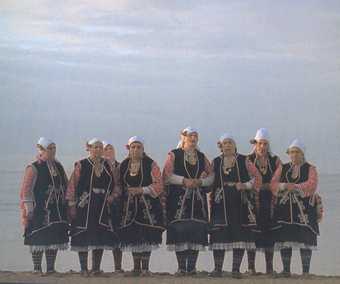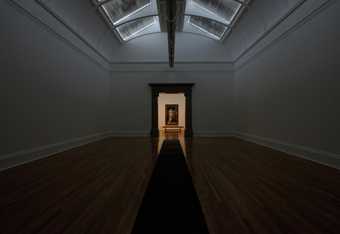- Artist
- Martin Creed born 1968
- Medium
- Film, 35 mm, shown as video, 4 monitors, colour and sound
- Dimensions
- Duration: 1min, 53sec
displayed: 1000 × 1300 × 440 mm - Collection
- ARTIST ROOMS Tate and National Galleries of Scotland
- Acquisition
- ARTIST ROOMS Presented by the artist jointly to National Galleries of Scotland and Tate and acquired with assistance of the ARTIST ROOMS Fund, supported by the Henry Moore Foundation and Tate Members 2011
- Reference
- AR01151
Summary
Work No.837 2007 is a four-channel video work with sound, shown on four monitors which are stacked on the floor on top of each other in a two by two grid. The video players are arranged behind the monitors. Each screen shows either a casually dressed young man or woman in an entirely empty, white environment where even the distinction between floor and wall is blurred by the luminous white background. Against this emptiness, a single person on each screen vomits profusely and repeatedly, before walking out of shot. The footage is looped.
In the year before he made Work No.837 Creed created several works featuring people vomiting. The first of these was Work No.503, a 35 mm colour film with sound of a young woman entering a white studio space and being sick before exiting the field of view. Other works of the same subject made in 2007 include the photographic print Work No.509, two 35 mm films called Work No.546 and Work No.547 (the latter produced as a DVD for commercial release), and Work No.583, which consisted of four synchronised films. To make these works Creed used footage he had shot for Work No. 610. Sick Film 2006 (35 mm, 21 minutes).
Critics have commented on the abject subject matter of Creed’s ‘sick’ works and on the experience of watching them. As Jonathan Watkins writes: ‘We are witnessing a kind of casual-smart regurgitation, a vomiting that is not desperate, but still tugs at our sympathetic nervous systems, tending to make us feel sick as well ... Sick, in particular, suggests a problem, and results from a fast involuntary reaction to something bad, or too much of a good thing.’ (Jonathan Watkins, ‘Shit, Sex and Sick’, in Ikon Gallery 2008, p.14.) Moreover, the fact that the footage is looped means that ‘any sense of relief is short-lived due to their [the actors’] reappearance seconds later’ (Jonathan Watkins, ‘Foreword’, in Ikon Gallery 2008, p.8). The critic Tom Eccles, however, has detected a satirical aspect to the work, suggesting that it parodies the manner in which the celebrated abstract expressionist painter Jackson Pollock dripped and splashed paint over canvases placed on the floor, captured most famously by the photographer Hans Namuth (Tom Eccles, ‘Interview with Martin Creed’, in Creed, Eccles, Gioni and others 2010, p.xvii).
According to Creed, however, Work No.837 seems in part to be a reflection on the creative act:
I was doing a talk and I was thinking that what I was trying to describe – the process of working – is a process of trying to get from the inside out. Being sick is a good example of that. And it’s a good example of something making something. It puts your insides out. You don’t really know what’s going to come out, it’s painful, but you feel better afterwards. The films are like portraits of people expressing themselves ... something uncontrolled. I am sick and tired of thinking. I want my work to be more like a vomit than a rumination. I just want to go ‘Blah!’ or ‘Woosh!’.
(Cited in Creed, Eccles, Gioni and others 2010, p.xvii.)
The work can be considered in the context of video and performance art, which came to prominence in the 1960s in the United States and Europe in particular. Such work was often based on somewhat absurd, deliberately childish, visceral, abject or dramatic actions performed before an audience or to camera. Examples include Paul McCarthy’s video Rocky 1976 (Tate T07713), Bruce Nauman’s Violent Incident 1986 (Tate T06732) and Raw Material Washing Hands, Normal 1996 (Tate AR00579), Marina Abramovic’s Cleaning the Mirror #1, 1995 (Solomon R. Guggenheim Museum, New York) and Roderick Buchanan’s Sodastream 1997 (Tate T07599).
Creed’s work is generally linked to a wide range of art movements from conceptualism, minimalism, situationism, abstraction and the Young British Artists movement of the 1990s. However, Creed often resists categorising his work according to such a lineage, remarking with an air of naivety and humour that ‘everything is kind of a little experiment in trying to make enough decisions to be able to come up with something I am happy with’ (Creed, Eccles, Gioni and others 2010, p.x).
Work No.837 was first exhibited at Ikon Gallery in Birmingham in 2008. Creed became the first new artist to join the ARTIST ROOMS collection after its formal establishment in 2008 when he donated a complete ‘room’ of his work in 2012, including this work.
Further reading
Martin Creed: Works, exhibition catalogue, Southampton City Art Gallery, Southampton 2000.
Martin Creed, exhibition catalogue, Ikon Gallery, Birmingham 2008, reproduced p.23.
Martin Creed, Tom Eccles, Massimiliano Gioni and others, Martin Creed: Works, London 2010, p.xvii, reproduced p.837.
Andrew Patrizio
The University of Edinburgh
June 2013
The University of Edinburgh is a research partner of ARTIST ROOMS.
Does this text contain inaccurate information or language that you feel we should improve or change? We would like to hear from you.
Explore
- emotions, concepts and ideas(16,416)
-
- formal qualities(12,454)
-
- photographic(4,673)
- repetition(391)
- actions: postures and motions(9,111)
-
- bending forward(353)
- vomiting(5)
You might like
-
Martin Creed Work No. 890: DON’T WORRY
2008 -
Martin Creed Work No. 1102
2011 -
Martin Creed Work No. 1103
2011 -
Martin Creed Work No. 1104
2011 -
Martin Creed Work No. 1105
2011 -
Martin Creed Work No. 1273
2011 -
Martin Creed Work No. 233
2000 -
Lucy Gunning The Horse Impressionists
1994 -
William Kentridge History of the Main Complaint
1996 -
Martin Creed Work No. 232: the whole world the work = the whole world
2000 -
Shirin Neshat Soliloquy
1999 -
Rodney Graham How I Became a Ramblin’ Man
1999 -
Jesper Just Bliss and Heaven
2004 -
Bethan Huws Singing for the Sea
1993 -
Martin Creed Work No. 227: The lights going on and off
2000


